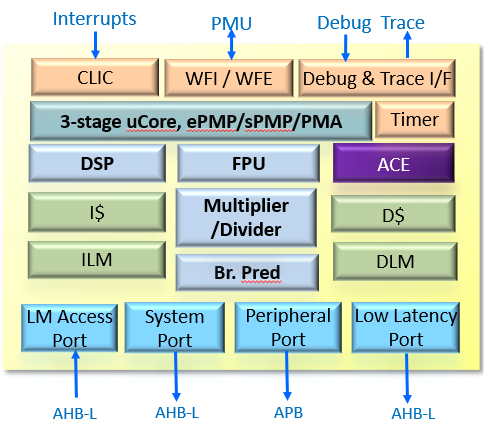Home | 產品與解決方案 | AndesCore™ Processors | RISC-V: D23
AndesCore™ D23
Compact, Secure and Performance Efficiency 32-bit RISC-V Core
AndesCore™ D23 Overview
- AndeStar™ V5 Instruction Set Architecture (ISA)
- Andes extensions for performance and code size enhancements
- 3-stage pipeline optimized for gate count and efficiency
- 16/32-bit mixable instructions for code density
- Instruction and data caches to speed up accessing embedded or external flash memory
- Branch prediction to speed up control code
- Enhanced and Supervisor-mode Physical Memory Protection (ePMP and sPMP) to enhance core security
- Core-Local Interrupt Controller (CLIC) for fast response, interrupt prioritization and pre-emption and Platform-Level Interrupt Controller (PLIC) for a wide range of cores and system event scenarios
- Patented CoDense™ technology to compress program code on top of the 16-bit extension
- Instruction Trace Interface supports RISC-V Processor Trace v1.0
- StakeSafe™ hardware to measure stack size, and detect runtime overflow/underflow
- Programmable Physical Memory Attributes (PPMA) for setting memory attributes dynamically
- PowerBrake, WFI/WFE (Wait For Interrupt/Event) for power management on different occassions
AndesCore™ D23 is a 32-bit 3-stage pipeline CPU IP core based on AndeStar™ V5 architecture for embedded applications with small gate count, and some dual-issue ability. In addition to commonly used RISC-V I/EMAC, single/double precision FPU and DSP extensions, it supports the recently ratified ISA extensions such as B (bit manipulation), K (scalar cryptography), and CMO (cache management operations) as well as Zce draft (code size reduction). The D23 implements ePMP and sPMP to improve core security; PPMA for on-the-fly change of memory attributes; and Andes V5 extensions that include StackSafe™ (for hardware stack protection), CoDense™, PowerBrake and WFI/WFE. The D23 supports both four-wire and two-wire JTAG debug and instruction trace interface for software development. On the performance front, it deploys several configurable options such as dynamic branch prediction, caches and local memories, multiplier optimized for performance or area. Moreover, it comes with rich features to ease SoC integration such as CLIC and PLIC for interrupt handling; an AHB-Lite system bus and an AHB-Lite low-latency interface; an APB bus for CPU local peripherals, and an AHB-Lite local memory access port for external bus masters. Some of the features will be implemented in CPU revision update, details below.
Development Tools
- AndeSight™ Integrated Development Environment (Eclipse-based)
- AndeShape™ FPGA Development Boards
- COPILOT: Automation tool for Andes Custom Extension™ (ACE)
- Debugging Hardware
Key Features and Performance
AndeStar™ V5 (RV32I) 32-bit Architecture
| Key Features | Benefits |
|---|---|
| |
| Andes Extended Instructions | Andes exclusive performance and functionality enhancements |
| 16/32-bit mixable instruction format | For compact code density |
| 32 general-purpose registers | For better code size or performance |
| Embedded systems with privilege protections |
*P-extension is in draft
CPU Core
| Key Features | Benefits |
|---|---|
| 2.0 DMIPS/MHz, 4.5 CoreMark/MHz | Superior performance-per-MHz |
| 3-stage pipeline | Optimized for gate count and efficiency |
| Static or dynamic branch predication | Speed up branch control codes |
| Enhance core security | |
| Programmable Physical Memory Attributes (PPMA), up to 8 regions | Basic read/write/execute memory protection with minimum cost |
| Performance monitors | Performance tuning |
| StackSafe™ hardware stack protection, planned in revision update |
|
Multiplier options:
| Option to choose between speed and area according to application's requirements |
Power Management
| Performance throttling to digitally reduce power consumption WFI instruction and WFE CSR for software power control |
Memory Subsystems
| Key Features | Benefits |
|---|---|
Unified read-only instruction cache, or Instruction and Data Caches
|
|
I/D Local Memory
|
|
Bus interfaces
| Key Features | Benefits |
|---|---|
|
|
Core-Local Interrupt Controller (CLIC)
| Key Features | Benefits |
|---|---|
| Up to 1002 interrupt sources, and up to 255 interrupt priority levels | Allow core local interrupts to be serviced and prioritized without sharing |
Enhanced interrupt features
|
|
Platform-Level Interrupt Controller (PLIC)
| Key Features | Benefits |
|---|---|
Implements RISC-V PLIC specification
| Interrupt handling for SoC with multiple processors |
Enhanced interrupt features
| Complete hardware preemption support |
Debug Support
| Key Features | Benefits |
|---|---|
| Implements RISC-V debug specifications | Supported by industry debug tool suppliers |
| 2-wire serial or 4-wire JTAG | Industry-standard support |
| Embedded Debug Module with 2/4/8 triggers | Flexible configurations to tradeoff between gate count and debugging capabilities |
| Optional password-based secure debug | Enhanced secure debugging |
Trace Support
| Key Features | Benefits |
|---|---|
| RISC-V Processor Trace v1.0 support | Support instruction trace according to RISC-V standard |
Standard Product Package
AndesCore™ D23 with AE350 Platform CPU Subsystem
- Pre-integrated D23, PLIC, shared debug system, and AHB AE350 Platform


